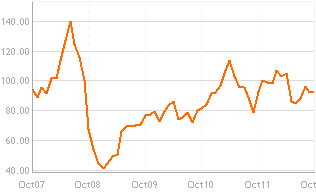The Growing Reach of Canadian Crude Oil
 Canadian oil has joined the ranks of the most-traded crude blends on the CME Group, an indication of the growing footprint oil sands production is leaving on broader crude markets.
Canadian oil has joined the ranks of the most-traded crude blends on the CME Group, an indication of the growing footprint oil sands production is leaving on broader crude markets.The Net Energy Inc. WCC contract, a financial trade based on the Western Canadian Select that is the country’s most prominent heavy oil grade, started slow. In the third quarter of 2010, just 210 WCC contracts changed hands. But in the past three quarters it has shot up, averaging 10,600 contracts a quarter. Current open interest stands at just under 20,000 contracts – some 20-million barrels – stretching through to December 2016.
Admittedly, it’s a very small fraction of the open interest in the West Texas Intermediate futures contract, which stands at 1.6-million for the top North American benchmark. Other long-established crude blends like Mars, a medium sour Gulf Coast blend and Louisiana Light Sweet, still see more activity than WCC, although it has begun nipping at their heels.
Dan Brusstar, senior director of energy research and product development at the CME, says WCC has in just a few years become “a benchmark in its own right. And I think once the production grows, and once the pipeline capacity opens up down to the U.S. Gulf Coast, it’s going to become an even more important benchmark.”
It helps that WCC has begun trading at a time when disruptions in pipeline capacity – from leaks and oversupply – have sent Canadian companies searching for a financial hedging tool.
But Calgary-based Net Energy, whose daily index WCC is based upon, has even broader plans. Canadian heavy oil is becoming a major source of global sour crudes. As that oil physically expands its reach – to southern and eastern markets, and potentially west through new pipelines – WCC stands to become “the third benchmark in the world” behind WTI and Brent, the North Sea crude grade, according to Net Energy president Tim Gunn.
That may be ambitious, although the CME says as the oil sands take an increasingly prominent role in the global energy trade, it’s likely financial trading based on that crude is also likely to grow.
WCC “is very quickly gaining speed and trading volume and importance, to the point where at some point it could even outpace some of those other benchmarks,” Mr. Brusstar said, referring to Mars and LLS.
“With the growing importance of Canadian production, once the pipelines get built to accommodate that production, it’s going to just continue to grow.”
Net Energy, meanwhile, has launched a product it calls NE2 Sour, which is designed to provide more clarity on the real value of Canadian oil. Rather than display the value of Canadian crude as a “differential” to other grades like WTI, NE2 Sour lists a single price. In other words, on a day when WTI trades for $90 a barrel, and WCS for $15 below, it is shown at $75 on NE2 Sour, rather than the traditional notation of –$15.
That’s a useful clarifier for broader markets, Mr. Gunn believes, since WCS is an important indicator of the health of Canadian oil companies, and often moves differently from WTI, which can prove confusing.
“Basically what it’s creating is a flat price for Canadian oil,” he said.

You can return to the main Market News page, or press the Back button on your browser.

